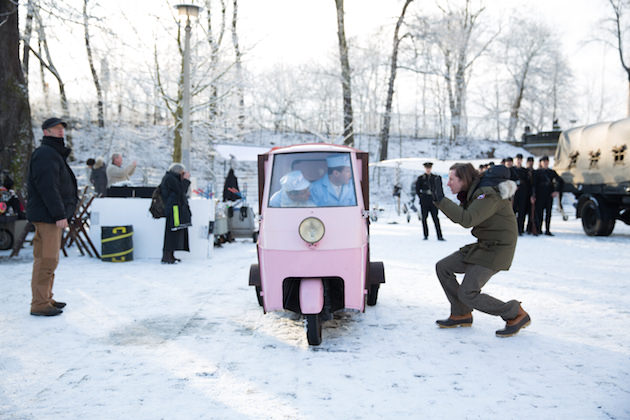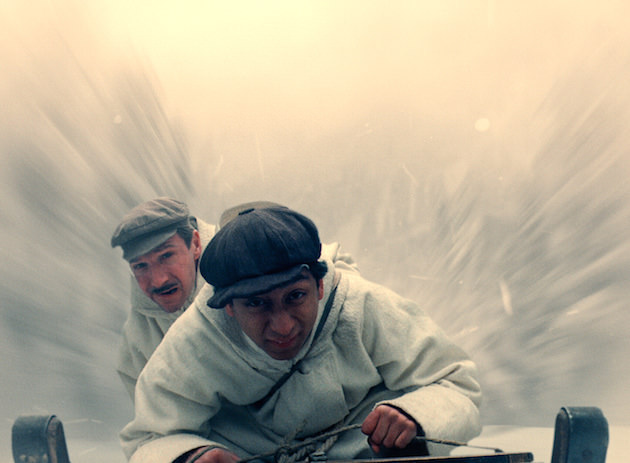The Grand Budapest Hotel’s Editor Barney Pilling
Editor Barney Pilling began his film career as a location scout on 24 Hour Party People, in 2002. A few years later, he’d become an editor, and worked on a string of narratively complex films, including An Education in 2009, the haunting adaptation Never Let me Go, from Kazuo Ishiguro’s difficult, daring novel, and One Day, in 2011, based on David Nichols novel which shows its two characters on the same date, every year, as it tracks their converging, diverging lives.
Piling’s most recent work was on Wes Anderson’s The Grand Budapest Hotel, which included all the hallmarks one expects from an Anderson film; a huge ensemble cast, an obsessive attention to the most minute detail, and perfectly blocked, framed and filmed sequences. It’s the latter part of that equation that requires the work of a crack editor. As gorgeously appointed as every Anderson frame is, his films are also marvels of finely wrought cuts, allowing his huge cast to run, fall, frolic, fight and most delightfully, talk their way through one astounding set piece to another in fluid motion.
We spoke to Piling about what it was like cutting a film this gorgeously wrought, with this many great actors, and which sequences he loved, and labored on, most.
How’d you get involved with the project?
I’d never worked with Wes before, but a few years ago I did a film called Never Let Me Go, and Mark [Romanek, the director] knows Wes, and I think Wes was making a film in Europe and he asked Mark if he knew any editors here who liked working the way Wes likes to work. So I had a Skype conversation with him, and it all happened it quite quickly.
Never Let Me Go was a powerful, underrated film if you ask me.
Never Let Me Go tackles major questions of what it means to human.
So how exactly does Wes work?
He’s very, very detailed, which is obvious. Every frame has tons of details, every inch of the frame, every stitch on the costume, and the same attention applies to all aspects of what makes a film in the editing suite. This includes the appreciation of dialogue, the many different takes, and the compositing of different vocal performances. Wes works in a highly detailed and technically demanding way in all of his departments. Look at the grip work; the grips who have worked with him will say the same thing. Technically, he works very fast, he’s very demanding, and he’s the same in editing suite.

How much footage were you looking at with The Grand Budapest Hotel?
There was a lot of footage, but I’m used to that from other films. It’s all very highly worked out because Wes’s sense of timing is so acutely attuned to his dialogue and rhythms, there’s not a lot of experimenting and bad takes. The moves and shots are all very thoughtfully composed before the camera roles. Part of my job boils down to making sure the cuts allow the dialogue delivered by these wonderful actors to be heard. Believe me, the set is a burning money pit if you’re not as well prepared as he is, a lot of time and resource and energy and indeed money can be wasted on not achieving anything. When the camera rolls on Wes’s set, it’s really economical, you’re getting lots of great material from great actors that can all be used in the film.
You mentioned how important the grips are, the crew members who actually control the motion of the camera.
Yeah, with that kind of grip work, and no digital replay on the camera, so there’s no motion memory, these are all hand moves made by a man pushing a grip. Sometimes there’s a bump, but largely there’s a lot of very good material to choose from.
Is Wes with you every day in the editing suite?
Not every day for the rushes, no .When you assess the scale of Budapest, the demands were so high, we didn’t get as much time together watching rushes, about every three days or so there was a huge cast member coming into town to do their little piece. At least once a week and some times three or four, we would indeed sit together and watch all of them, and he’d make notes and really begin that process of honing down those performances.
How do you discern between a bunch of really good takes?
It’s such a genie in a bottle thing, a soulful thing, because what feels right to one person feels wrong to another. There’s always room with the way Wes works for happy accidents, he has a such strong sense of how things should go, but with Ralph [Fiennes], such a master of language, and you put him together with an Ed Norton, Tilda Swinton, with that kind of humor it becomes reasonably obvious that there’s funnier takes than others. It’s a very physical humor with the shots he composes, those precise two shots and the timing of what the actors do and when they do is largely part of the camera and the take itself. Some of the nuances of how lines should be inflected could only be decided upon by Wes himself. He wrote this script, so he knew what he wanted in lots of cases. You’ll have some arguments, I prefer take ten, he prefers seven, so we’ll try both, decide on one, and then maybe three weeks later you’d switch one out for the other. It’s really hard to discern any kind of formula for what take works.
So much of the magic of his films, especially Budapest, is the rhythm to the scenes.
He does have really strong ideas on inflections and rhythms, and most of the time it’s all about striving to achieve his vision of rhythm and humor, but some takes come alive for no apparent reason, it’s just two great actors performing really well.
Was there any difficult sequence that stood out for you?
I’d have to say ski and sled chase down Gabelmeister’s Peak. Once the character has been killed and they’re chasing Willa Dafoe’s character, it was such a blend of forms and styles. For me, who comes from European background, I’ve never had that many special effects before. That was the most challenging sequence for me. Wes was pulling footage from so many areas; green screen, animatronic puppets, storyboard animations, miniaturized landscapes shot with a 5D that people built, live action, so many different elements had to come together. This was why it was the last sequence to be locked, because of all these different elements. We had to work out the rhythms, the many subtleties, the fine detailing of the cuts, and the music and what that should do. We’re in the imagination business, we’re paid to be imaginative, you can get close, and that scene took the most pushing to get right.

Did you have a sequence you particularly loved cutting?
The whole damn film [laughs]. A more subtle answer to which was the most satisfying sequence that came together and suited my sensibility was the sequence when Gustave and Zero visit Madame D’s reading of the will. It's a low build that begins in train carriage and ends when they leave Madame D’s house with the stolen painting, the way we built that, and the performances, beginning with Jeff Goldblum reading the will, it just had a beautiful rhythm to it, and the punch up that happen at the end of it, it just just felt really good. When it all came together you couldn’t get sick of watching it. Instead of assessing it for mistakes, which you'll do, but just to sit and enjoy it was great.
How much time did you have to edit the film?
We had ten weeks, which I consider prep work when the director’s shooting, getting material, choosing selects, getting it together. The real hard work starts when Wes finishes shooting, then we spend 11 very intensive weeks to get the film complete. It was around about the length it should be, we then worked on it another 10 to 20 weeks in different stages of the process, including sound editing, which Wes likes to do earlier, then it's visual effects, etcetera.
Editing is sort of brutal work, being inside the editing suite all day, sometimes all night, staring at the same scenes over and over again.
Dealing with repetition, it either suits people or doesn’t…I’ve never had a problem with it, I was once a DJ, I’m used to repetitive media. I never grow tired of it, I never look at the watch when I’m doing it, it’s like when I was a child building models, time just disappears. The hours are long, which is taxing on the psyche and physique, but it doesn’t wear me down.
Can you watch Budapest yet and enjoy it?
It takes a long, long, long time. It does take a number of years to forget the work you’ve done and see the film the way audience does. Now when I watch it, I remember every edit, every sound effect, there are no surprises. One of the key aspects of going to the cinema is to be surprised, to be surprised of what comes next. After a few years I can watch it and forget most of what we did.
Featured image: Zero (Tony Revolori) and Agatha (Saoirse Ronan) in The Grand Budapest Hotel. Courtesy Fox Searchlight Features.



